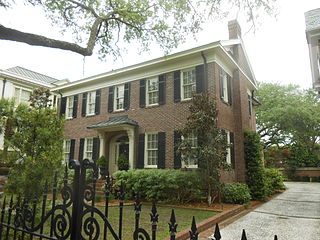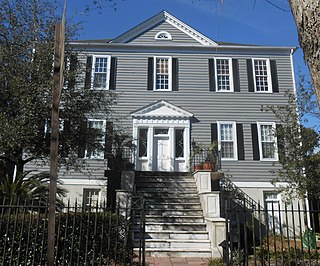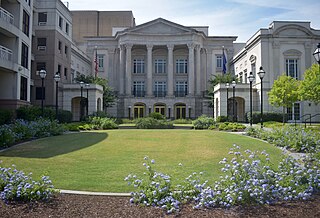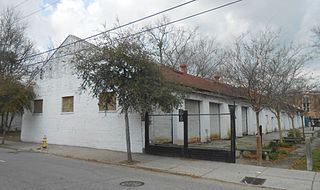
Marion Square is greenspace in downtown Charleston,South Carolina,spanning six and one half acres. The square was established as a parade ground for the state arsenal under construction on the north side of the square. It is best known as the former Citadel Green because The Citadel occupied the arsenal from 1843 until 1922,when the Citadel moved to the city's west side. Marion Square was named in honor of Francis Marion.

Joseph Patrick Riley Jr. is an American politician who was the Mayor of Charleston,South Carolina. He was one of the longest serving mayors in the United States that is still living,having served 10 terms starting on December 15,1975,and ending on January 11,2016.

Burnet Rhett Maybank was a three-term US senator,the 99th governor of South Carolina,and mayor of Charleston,South Carolina. He was the first governor from Charleston since the American Civil War (1861-1865) and one of twenty people in United States history to have been elected mayor,governor,and United States senator. During his tenure in the Senate,Maybank was a powerful ally of President Franklin D. Roosevelt. His unexpected death on September 1,1954,from a heart attack,led to Strom Thurmond being elected senator.
More than 1,500 African American officeholders served during the Reconstruction era (1865–1877) and in the years after Reconstruction before white supremacy,disenfranchisement,and the Democratic Party fully reasserted control in Southern states. Historian Canter Brown Jr. noted that in some states,such as Florida,the highest number of African Americans were elected or appointed to offices after the end of Reconstruction in 1877. The following is a partial list of notable African American officeholders from the end of the Civil War until before 1900. Dates listed are the year that a term states or the range of years served if multiple terms.

John Henry Devereux,also called John Delorey before 1860,was an American architect and builder best known for his designs in Charleston,South Carolina. According to the National Park Service,he was the "most prolific architect of the post-Civil War era" in the Charleston area. His works are listed on the U.S. National Register of Historic Places. His Charleston Post Office and Courthouse has been designated as a U.S. National Historic Landmark.
The following is a timeline of the history of Charleston,South Carolina,USA.
John Palmer Gaillard Jr. was an American politician who was mayor of Charleston,South Carolina from 1959 to 1975. The Gaillard Center is named after him. During his tenure,Gaillard significantly expanded the size of Charleston by annexing nearby neighborhoods.
Thomas Roper (1760-1829) was the tenth intendent (mayor) of Charleston,South Carolina,serving two terms between 1799 and 1801. As mayor of Charleston,he was influential in the move to build a chapel at the Charleston Orphan House;it was completed in 1801. He died on April 15,1829,and is buried in the graveyard at St. Philips in Charleston,South Carolina. Because his only son died without an heir in 1845,Col. Roper's real estate on East Battery and Queen Streets passed to the Medical Society of South Carolina. Roper Hospital is named in his honor.

William McG. Morrison was the fifty-seventh mayor of Charleston,South Carolina,serving between two terms between 1947 and 1959. He was the first person elected to three terms as mayor of Charleston as a result of his win in June 1955. He lost his fourth bid by 455 votes to J. Palmer Gaillard,Jr. on June 9,1959.

Henry Whilden Lockwood was the fifty-fifth mayor of Charleston,South Carolina,serving between 1938 and 1944.
Thomas Porcher Stoney was the fifty-third mayor of Charleston,South Carolina,serving between 1923 and 1931.
Arthur Bonnell Schirmer Jr. was the fifty-ninth mayor of Charleston,South Carolina,completing the final four months of J. Palmer Gaillard,after Gaillard's resignation. He did not run for election for a full term.
E. Edward Wehman Jr. was the fifty-sixth mayor of Charleston,South Carolina,completing the term of Henry Whilden Lockwood and not running for reelection. He was born on December 27,1891,in Charleston,South Carolina to E.E. and Bertha T. Wehman. He attended West Point in 1911 and 1912 and received a bachelor of science degree from the University of South Carolina. When Dwight D. Eisenhower,a classmate of Wehman's at West Point,was elected president,Wehman served as one of the eight electors from South Carolina.
William W. Sale was the forty-fifth mayor of Charleston,South Carolina,serving one term from 1877 to 1879. He was born in September 1819 in South Carolina and married Edith Cleapor in about 1871. Before being elected,Sale worked as a teller at the First National Bank in Charleston. Sale was endorsed by the Charleston News &Courier,and he was elected on December 11,1877 by a margin of 5,288 to 1,924 in an election against D.F. Fleming. Sale was inducted on December 17,1877. As mayor,Sale lived on Chinquapin Street. After leaving office,he was the master of the Charleston Alms House. In 1900,he was living in Summerville,South Carolina.

Charles Macbeth was the thirty-seventh mayor of Charleston,South Carolina,serving three full terms and a partial term between 1857 and 1865. He was born on January 24,1805,in Charleston,South Carolina,and he died on November 30,1881,in Pinopolis,South Carolina. From 1830 to 1865,he was part of a Charleston law practice.
John Huger was the sixth intendent (mayor) of Charleston,South Carolina,serving two terms from 1792 to 1794. He laid the cornerstone of the Charleston Orphan House,one of the city's most notable buildings,on November 12,1792. Before the Revolutionary War,he had been a member of the Commons House of Assembly and a member of the Council of Safety,the group that organized revolutionary movements in Charleston. The location of Huger's estate,Hagan Plantation,was included in an almost 5,000 acre conservation easement.

John Dawson Jr. was the sixteenth intendant (mayor) of Charleston,South Carolina,serving two terms from 1806 to 1808.

John J. Tecklenburg is an American businessman and politician. He served two terms as mayor of Charleston,South Carolina,sworn in on January 11,2016. Tecklenburg was defeated in 2023 by former state legislator William S. Cogswell Jr. He became the first mayor of Charleston to lose a reelection campaign since 1959.

The Gaillard Center is a concert hall and performance venue in Charleston,South Carolina. It opened in 2015 and replaced the Gaillard Municipal Auditorium. Both buildings were named after John Palmer Gaillard Jr.,mayor of Charleston from 1959 to 1975.

The Charleston sanitation strike was a more than two-month movement in Charleston,South Carolina that protested the pay and working conditions of Charleston's overwhelmingly African-American sanitation workers.










